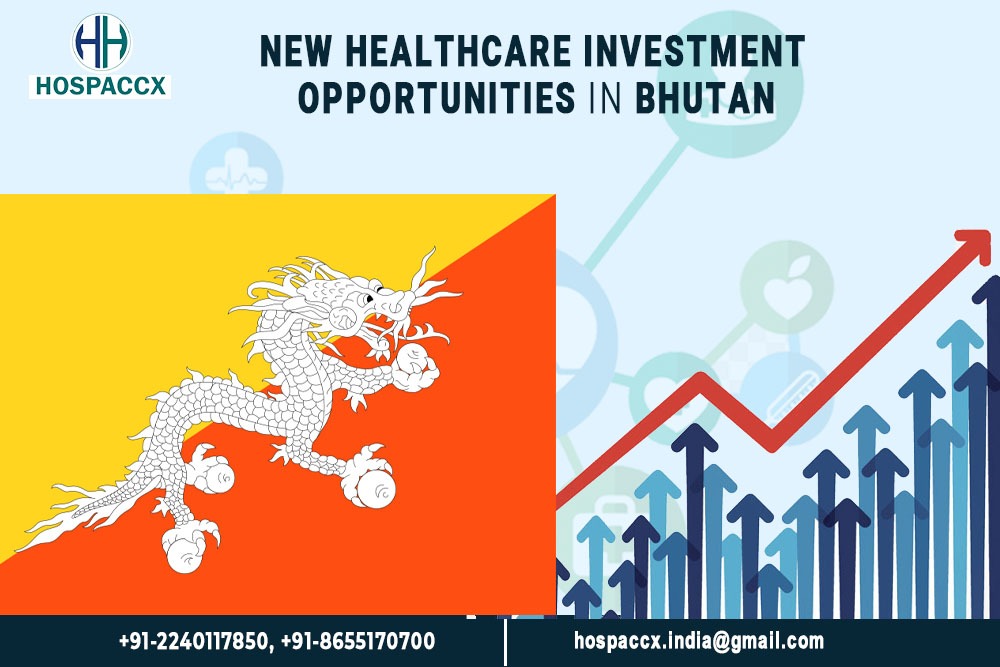New Healthcare Investment Opportunities in Bhutan
The economy of Bhutan has achieved great gains, notably during the previous four five-year plan (FYP) periods, guided by the underlying ideology of Gross National Happiness. The philosophy of Gross National Happiness, as envisioned by His Majesty the Fourth King in the late 1980s, describes Bhutan’s development goal as a decisive improvement in people’s happiness and contentment rather than mere growth in Gross National Product (GNP). The nation believes that it is critical for the holistic development of the person and community that development achieves a sustainable balance between the people’s economic, social, emotional, spiritual, and cultural requirements. Though health-care policies and programmes are developed and executed in accordance with the Gross National Happiness concept, a national health policy was developed through a consultation process and adopted in 2011 to offer clear written direction for health sector development.
Healthcare is delivered to the citizens of Bhutan through 49 hospitals including the National Traditional Medicine Hospital (NTMH), 186 Primary Health Centres, 53 Sub-posts, 542 Outreach Clinics (ORCs), three Thromde Health Centres, and five Health Information and Service Centres. There are 5,901 healthcare workers who cater to its population of 857,423.
Economic Snapshot of Healthcare in Bhutan
According to the National Health Accounts (NHA) 2021, out-of-pocket spending remains an issue, despite the fact that the government contributes more than 80% of overall health expenditures. Out-of-pocket spending exceeded Nu 1.108 billion (B) and accounted for 18 percent of current health expenditure (CHE) in fiscal year 2018-2019, rising to Nu 1.180 billion (B) in fiscal year 2019-2020, accounting for 15 percent of CHE.
According to NHA 2021, the total CHE for fiscal years 2018-2019 and 2019-2020 was Nu 6.233B and Nu 7.656B, respectively, and includes expenditures made by the government, corporations, and households during the fiscal year, as well as the cost of capital assets used in the health system. The government’s contribution to CHE was around 3% of GDP for both years.
Investment Growth Potential
Over the previous few decades, socioeconomic growth has significantly decreased the number of people living in poverty, increased GDP per capita, and improved living standards. Bhutan has achieved yearly average economic growth of more than 7% over the last decade, according to the World Bank. Bhutan is also one of the region’s growing economies, according to the Asian Development Bank.
Bhutan’s Royal Government has launched a variety of economic growth and diversification measures in order to strengthen its economy and play a more active part in the global economy. One such project is the Royal Government’s determined effort to attract Foreign Direct Investment (FDI) by liberalizing the FDI laws, modernising its economic strategy, and establishing a suitable environment.
Changing disease profile: Bhutan’s modernisation has been matched with modern health concerns; instead of malaria and polio, Bhutan today tackles addiction, mental diseases, HIV/AIDS, and other major issues. The three most significant challenges are systemic healthcare issues, noncommunicable illnesses, and mental health difficulties. Bhutan’s healthcare system is also facing issues. The most notable issues include a lack of accurate documentation, uneven access to care, and insufficient providers.
Healthcare Investment Opportunities
With a population of about 750,000 people, Bhutan itself has a small domestic market. Nonetheless, there are varied opportunities for small and medium-sized investors as well as larger transnational corporations (TNCs). Construction is booming due to rapid urbanization, particularly around Thimphu, as well as due to hydropower projects, which are the most important driver of economic growth. Public–private partnerships (PPPs) are encouraged for infrastructure projects.
Herbal Medicine: Medicinal and herbal products have an incredibly high exploitable potential in Bhutan, which has yet to be completely explored or investigated in depth in terms of the long-term development of “Made in Bhutan” traditional medicines for the global market. Bhutan contains hundreds of plants with medicinal and aromatic characteristics that may be used in cosmetics and health care products in important markets such as India and other Asian, Middle Eastern, and Western nations. Bhutan trades the majority of its medicinal and aromatic plants in raw form.
Healthcare Tourism: Branded natural healing clinics, where traditional rejuvenation treatments are combined with modern culture, might be created and promoted to attract visitors. These centres will perform admirably and will be consistent with the GNH ideology of economic growth without jeopardizing Bhutanese culture’s essential values. Neighbourhood India is a large market, and franchise-based clinics offering treatment utilizing ‘Made in Bhutan’ ethnic herbal and therapeutic items such as essential and aromatic oils and other natural products might be established in major Indian cities in the future.
Research and Development: In the context of Bhutan, research and development is a new area. Given the clean environment and a growing educated workforce, this industry has a lot of promise for future investment. Diagnostic laboratories, industrial and environmental (emission) testing laboratories, medicinal plant and drug formulations laboratories, food testing laboratories, and international standards services are just a few of the sectors with future investment potential in this industry.
Medical Infrastructure: The structure and facilities in Bhutan are far from satisfactory and this will create a major problem for the best brains to come to Bhutan for a longer period of time. There is a very good scope of FDI for private medical facilities.
Conclusion
Bhutan has invested heavily in health infrastructure in recent years, including both secondary and tertiary hospitals and a large network of primary health facilities serving both urban and rural areas. Investing in the health system not only saves lives, it is also a crucial investment in the wider economy. This is because ill-health impairs productivity, hinders job prospects and adversely affects human capital development.
While the country is investing in the health of it’s citizens, it is also looking for foreign investments to strengthen its health and service infrastructure. The prospects of investing in Bhutan are lucrative to investors because of it’s English speaking workforce, Environment Friendly Low-emission development, Political stability and transparency, Subsidised electricity and a sense of exclusiveness and appeal in its sustainable approach to development, which is guided by the development philosophy of GNH. 100% foreign ownership is allowed in certain activities such as education, health, hotel & resorts and infrastructure facilities under services sector. Bhutan offers tax Holiday of 5 to 10 years depending on the sector, Sales Tax and Customs Duty exemption on import of Plant and Machinery, raw materials & primary packaging materials and 10 years tax exemption on convertible currency earnings from manufacturing and IT/ITES services. Because of it’s sustainable approach, Bhutan also allows a tax rebate of 15% on environmental up-gradation.
Bhutan’s growing economy, it’s emphasis on happiness, health and sustainability, combined with the above factors of its changing disease profile and friendly FDI policy make it a great destination for healthcare investment projects.
For more information about the Country and Healthcare opportunities in Bhutan, you can visit the company website on www.hospaccxconsulting.com or contact us directly.
Related Team Members










